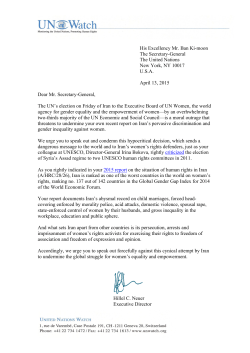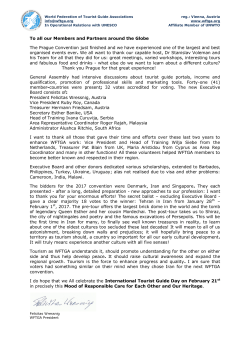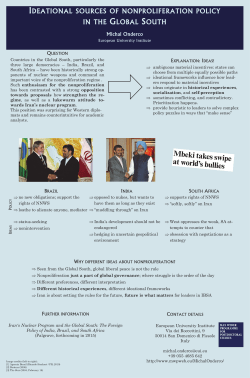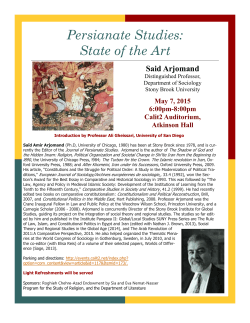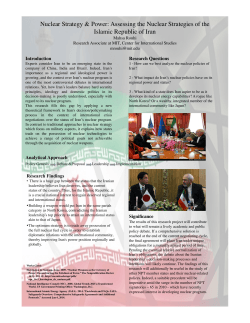
The evolution of urban planning in developing countries compared
Jurnal UMP Social Sciences and Technology Management Vol. 3, Issue. 2,2015 The evolution of urban planning in developing countries compared with developed countries Zeinab Karkeh Abadi Associate Professor, Department of Geography and Urban Planning, Semnan of Branch, Islamic Azad University, Semnan, Iran Sasan Masoudi P.Hd Student, Department of Geography and Urban Planning, Semnan of Branch, Islamic Azad University, Semnan, Iran Abstract In recent years, urban planning has been discussed as an important issue in all societies and a vast literature is devoted to urban development. In this regard, various aspects of urban planning were studied and analyzed from different angles , and some solutions have been devised for them. Comprehensive approach to policies, programs and urban development projects, and also the formulation of integrated economic, social and environmental goals are at the head of sustainable urban development policy and planning. Realization of these goals requires the evaluation of the results and consequences of urban systems for the economic, social, cultural, environmental changes , and major changes in the organization and urban planning are required too . balance between large and small urban centers, cooperation between government departments, public and private sectors , as well as developing local strategies to achieve urban planning policies in the countries are important aspects.this article has studied The evolution of urban planning in developing countries compared with developed countries. Evolution of urban planning in the two countries is analyzed. After reviewing origin of concept of Urban planning and its goals in this paper, we study History and evolution of urban planning in the world. Then, Important indicators of urban planning are studied Including the role of government, housing and good living environment, culture, popular participation, social justice in the evolution of urban planning in the two countries group. Finally, Features of new cities in these countries were studied. Keywords: Urban planning, evolution, developed countries, developing countries, new cities. Introduction characteristics of crrent urban communities has been resulted in instability of human beings and the environment (natural and built environment) . civil and human society faced by some problems including poverty and injustice, individualism, extreme greed, disintegrating social relations, family instability, uneven and unbalanced pace of everyday life, the loss of urban identity, the loss of natural and cultural riches, reducing public participation in the decisionmaking process, human vulnerability and urban environment caused by natural disasters (earthquakes, floods, etc.) and human (pollution, accidents, crime and crime, etc.), lack of environmental comfort in living spaces, limitless energy consumption and irrational use of renewable resources and .... By 2015 the world's urban population would be more than 3.9 billion. Twenty-first centuries is the century of cities and urbanization. Most urban growth will take place in developing countries. Human being is looking for an ideal city to establish basis of sustainable development. At the United Nations Conference on Environment and Development in 1992, the Rio Declaration was signed by 150 countries. In particular, some principles were signed for achieving sustainable development, a development that meets the needs of today's man, without destroying the ability of future generations to access to their hopes and needs (Mojtahed Zadeh, 2014). Urban planning as a scientific discipline emerged in late 1900s. In 15 The evolution of urban planning in developing countries … www.jsstm-ump.org Great Britain, the first academic program planning began at the university of Liverpool in 1909. The first program was established in North America in 1924 at Harvard University. The first course was taught at the graduate level. Its curriculum varies widely in different institutions. Some of the traditional programs, emphasis on physical layout of land. Other programsespecially those awarded a Ph.D degree - are more the social sciences oriented. The theoretical basis of this discipline, partly because of the lack of transparency, is introduced by the issues it presesnts than dominant paradigm or any prescription approach. The mentioned topics often include : Recognition of a general trend and how to determine this trend, Physical and social characteristics of an ideal city, Possible changes in accordance with the smart objectives, possibility level of agreement on goals by communications, The role of citizens in government officials and private investors in shaping the city, Accurate quantitative analysis and logical models of decision-making at a methodological level. Most of programs in urban planning phase mainly includes practical courses on topics such as environmental policy, transport, housing planning and economic development of society ( Nazariyan, 2014). According to the above-mentioned issues, we are going to study evolution of urban planning in developing countries compared with developed countries. Theoretical framework Definition of urban planning Planning is done based on area or field of work in different levels including National, regional and local land-planning. In urban planning, some topics are studied, including urban factors, how to use the lands -housing-traffic-green space, in relation to population and city performance ( Zayari, 2013). The nature and evolution of urban planning As mentioned at the beginning of the discussion, importance and urgency of the urban planning dates back to antiquity human history, especially in the wake of the Industrial Revolution in Europe. Urban planning was derived of architecture. Urban planning began since physical planning. It considered engineering and architectural aspects of city-building infrastructure and housing and urban beautification engineering and architectural aspects of city-building infrastructure and housing and urban beautification. Hippodamus was the first person, who discussed about urbanism who lived in 480 BC. Plan was interesting in the middle of 19 century since beginning of new style urban planning. After World War II, opportunity of paln was decreased . plans and comprehensive programs were critiziswed severly. Despite the eloquent and good defense of the plan, practice and theory went toward the process. City planners were advised to take a more moderate approach to the issues than comprehensive one. Firstly, theorists insisted on the division and then dialogue and communication actions. Paradoxically, this situation was placed beside the fact that many improvements have been the result of projects (Dona j. Stewart, 1996). The origins of modern urban planning Origin of modern planning is known is dedicated to Husman’s plan for Paris in the moddle of th 19 century by historians. In other words, modern planning was started in the late of 19 centurt and formation of some movements to improve housing and sanity of city in Germany and England and USA. The first urban master plan, claimed considering issuing important for contemporary planners including housing, Eco, traffic, social and sanity situations, urban design, density of infrastructures that was presented by a civil engineering as Ied Fons Serda for Barselona in 1859. His plan was based on the theory of urbanization ( Taghvayi saravani, 2009). Classification of the evolution of urban development projects in the world Preparation of urban development programs with modern sense in the world does not enjoy of antiquity, but the eneavors inthis regard originates of last times. The primary efforts that have been typical in the regulation of human settlements, has provided the first source of program development. 15 Jurnal UMP Social Sciences and Technology Management Vol. 3, Issue. 2,2015 4 stages are considered as stages of the evolution of urban development projects in the world. The first stage was presented as formation of the idea of Utopia to solve the problem of citizens ( 1800-1900 AD). The second stage ( 1900-1950 AD) : the first ideas based on planning were formed by preparing development plan for European cities , such as Amsterdam, Paris and London. Third stage ( 1950- 1970 AD) : Formation and formulation of Athens Charter and attention to quanitative standards of civil life . The fourth stage ( after 1970 AD) : attention to the non-physical aspects of cities and creating new approaches in urban development planning ( Moradi Masihi, 2009). The first stage ( 1800-1900 AD) In this period, urbanism was not formed as an independent job. Social theorists are the main people who have some idea about urban development method to solve problems of social levels. They mention some specifications of ideal city. General ideas have been proposed as utopia. It consideres suitable city out of the current cities. So, they think about laboratory situations, as any limitation should be removed as premise, to realize the utopia. Due to this reason, the best opinions expressed in this period, such as Robert Owen fictional town ( 17711858) and Falansar shawl February ( 1772-1838) are not realizable at all (Moradi Masihi, 2008). The second stage ( 1900-1950) 20 century was begun by many developments in science field. Theories based on inductive reasoning and the development of experimental techniques was prevalent in all of sciences.preparation of rules argument based on scientific philosophy forms the basis of the methodology. Logic rules are considered as recognition basis in natural philosophy. The first rule: For the reasonong of natural things, some true reasons should be used to be enough for explanation of appearances. The Second rule: the same reasons should be attributed to the same causes. The third rule: those specifications in all objects available for test.they should considered as universal qualities of all bodies The fourth rule: those rules that are obtained by general induction, they are due to exploring in the phenomena .Opposite assumptions should be ignored. Consequently to formulate logical rules and laws of reasoning in all sciences, Theoretical foundations of modern urban forms in this period, and all the experts try to express the Inductively experience based on scientific evidence. For this reason, various ideas were proposed about urbanism in this period, some of the include: 1-the linear theory by Arturo Soria . 2-Theory of Industrial City by Tony Garynh [12] ( 1869-1948) 3-Garden City Theory By Ebenezer Howard [13] ( 1850-1928) 4-shining city Theory by Le Brzyh [14] ( 1887-1965) The first half of the twentieth century, provided a good situation for more logical thinking about the concept of urban development. Therefore, fourth Congress of Modern Architecture (SIAM) is allocated to urbanism completely. A sample pattern is provided by it to provide urban maps. According to it, 3 maps should be prepared for a city, one for showing how to use the land , the second for showing passages , and the third for completing position of city according to its surrounding area. The above pattern is used to prepare urban development patterns for 33 cities including London, Paris, Berlin, Ditroit, and Madrid. But this pattern shows maps of the situation. In addition, between the two world wars, methods that are used to organize large cities are largely fragmentary. Urban general plans do not go beyond the boundaries of urban centers (Moradi Masihi , 2008). The third stage ( 1950-1970) Phase III of urban development studies refers to the post-World War II and its result is the destruction of a large number of cities in fighting. Fast reconstruction of cities and the use of modern urban planning theory to provide urban development plans are evident for all people . due to the requirements of reconstruction programs, efforts to address the imbalance in 15 The evolution of urban planning in developing countries … www.jsstm-ump.org distribution of population, production facilities and infrastructure services, spatial planning at regional and municipal levels are considered. In this period, the most important physical characteristics of the planning and design are realized in 2 different areas as follows: Urban development projects in the form of a comprehensive plan, including general and longterm urban development plan for long term (usually 20 years) Detailed plans as comprehensive plan wizard, to carry out the main objective of the project proposals for urban master plans, detailed designs inspired of the principles of functional urbanism prepared in 1933 in the fourth International Congress of Modern Architecture ( Moradi Masihi, Khalij, 2008). The fourth stage ( after 1970) Since the late 1960s, Failure to realize the aims and ideals of the traditional comprehensive urban development plan, and spread of new ideas of planning and knowledge in science resulted in appearance of need to change the way of urban development plans. For this reason, British urban planners offered the need for the application of the system methods in planning and urban design with emphasis on the general theory of systems. After that, changing in the thinking method of comprehensive traditional designs that concerned with unidirectional relationship of elements was changed to reciprocity view of elements of set. In new look and systematic analyse, city is as a complex potential evolving dynamic phenomenon that is active. Its developments should be studied in the context of a dynamic system. According to the systemic method, the planning process is a continuous cycle of analysis and conclusions stages that is is replaced for inference process.in the traditional approach, the identification and analysis of the present situation was prior to the conclusion . but, in the systemic method, determining the purposes of research and information gathering, modeling and assessment, and implement solutions are replaced. In other words, non-target comprehensive forecast is replaced by the process of planning in urban development projects including monitoring until the implementation. Perhaps for the first time, the urban development plan is altered of the physical map to the urban development plan. Due to the random nature of the approach based on the conditions of uncertainty, limitations of human knowledge and restriction of authorisation and human control are specific feature of urbanization of this period of time ( Moradi Masihi, 2008). Evolutions of urban planning in developed and developing countries in industrial era Technology was accompanied with rapid population growth, unlimited business investment, big profits and the government's failure to manage of the unintended physical consequences in Europe and USA. Large cities were developed in this period of time. Large population growth, unlimited commercial investment, large profits, defeating government in management of th unwanted consequences of development were other events in the middle and last of 19 century. Luxe caused by poverty, and wealth caused by nihilism were shown offensively along with this development. Finally, corruption and abuse arising from this course led to the emergence of progressive movement based on that, the urban planning was changed to a part. Marginalized places and impoverished neighborhoods caused overcrowding and congestion, ugly and threatening reaction illnesses. After this reaction, the first request was formed for health improvements. Due to improvements in water supply and wastewater engineering, health was increased significantly, which was essential for more growth of civil population. At the end of this century, the first steps were taken to correct housing conditions. In the basic regulatory rules, the basic standards were set for housing construction (Such as the Public Health Act of Great Britain in 1848 and the real state of New York in 1879). Administration was run slowly, because governments did not provide the required capital for modernization and improvement of existing homes. Also, low ability of residents of poor places to pay rent fee, did not encourage homeowners to improve home. When the new buildings were built, some developments took place in housing. New legislation continued reflection to disclosure of researchers such as Jacob Riis in USA and Charles Booth in Britain. Concerns about the appearance of city in Europe was found a long time ago in tradition empire of building Court 15 Jurnal UMP Social Sciences and Technology Management Vol. 3, Issue. 2,2015 and House and also the construction of large government buildings in central squares and churches . Good scenery and symmetry of squares and streets radiating out was changed into the large-scale planning in Paris during the second empire Georges Eugene Baron Husman (1852-1870) by supporting direct arterial boulevards. The resulting urban form was simulated widely in other parts of Europe. Although, Husman's proceedings were based on beautification, these proceedings broke trade barriers provided by the Middle Ages Paris, and could provide a suitable basis for effective transportation of military goods. His plans included demolition of old houses and property, and replacing it by new apartments for richer customers, construction of transport roads and commercial spaces, and movement of poor people to central parts of city.Husman's method provided a frame that open plan of urban developments are th administered in Europ and USA until the end of 20 century. These programs expand their impacts in most parts of the third world. Approaches of urban planning development after World War After world war, European governors administered large housing and reconstruction programs in their ruined cities.This program is based on the principles of modern planning and were published in the International Congress of Modern Architecture (SIAM). According to ideas of Siegfried Giedion, historian of art and architecture, Lukurbuziye was Swedish Architecture, and international school of Bauhaus was german. In this period of time, high buildings were built, separated of each other by green spaces. Form of these buildings showed requiring production in large scale. Also, it showed tendency of architectures to models for applying new technologies and new materials. They are repeatable in the entire world. Government intervention in housing development provided more possibility for public part to control urban growth pattern by its investments, rather than relying on legal tool as a tool of making limitation for expensive development of private sector ( Barton et.al, translate by Barooti, 2009). The government's role in the development of urban planning of developed and developing countries The performance situation of urban planning was developed in the structure of city government in different countries. Today, in many countries, private sector developers must obtain a permit of the state for construction. However, in the United States, if the project developers will meet with municipal zoning laws, they will be permited to construct as their right. In Europe, which urban management is heavily concentrated, urban planning is done in the field of administrative organization which has considerable strength. In Great Britain, while a planning organization acts in the executive and advisory capacity field, local elected council is responsible for local planning. Developers whose construction license is rejected, can request the central government to appeal their sentences. In order to deal with the issue of growth and social welfare, some countries, particularly in northern Europe, national governments have changed urban planning as a part of their proceedings. Even in the United States, federal government was involved in local planning issues by production and implementation of national housing and urban renewal law by the supervisory role of the federal Housing and Urban Development organization, established in 1965. When developing countries in the 1960s and 1970s became independent of colonial powers, the planning structure was highly centralized by national governments, usually set the new urban plan frame ( Barton et.al, 2009). Comparison of urban sustainable development in urban planning of developing and developed countries In his paper as " dense cities in developing countries " , Harry Richardson starting from the fact that although urban density in several cities of developing countries is more than developed countries ,urban sustainability of cities of developing countries is less than their developed counterparts . According to Harry Richardson, the main differnce between cities of developing countries and developed countries is their transportation system. In other words, high density and unsuitable transportation system is dangerous environmntal health and stability of city. It increases instability of city. According to Richardson, "all of theses things mean that dense 11 The evolution of urban planning in developing countries … www.jsstm-ump.org cities of developing countries are not planeed. There is not a pre-determined plan. On the contrary, On the contrary, density of these cities is made automatically or with chaotic ( Bahreyni, 2000). Good housing and living environment in changes in urban planning of developing and developez countries In developing countries where personal profits prevail on public profit and investors think just about themselves ,it is essential to consider conflict between public interest and individual profit . it is necessary to prevent inflation and undesirable development of cities by controlling land as land policy strategy, or establishing land bank . The land storage policy, that is called as land bank, requires more proceedings, such as buying land when it is cheap, storage of public lands for fture consumptions, changing undesirable public lands with those lands that have more value in future, private land reclamation in exchange for its costs as capturing the private reclamationed land for public use ( Taghvayi Sarvani, 2004). Culture preservation and local wisdom in developing and developed countries urban developments planning Such protection often involves a conscious effort by the government to support traditional crafts, language, customs, culture and methods of construction, preserving important local products against high imports, protecting crops and local resources, merging architecture and indigenous materials. There are strong economic and military forces in some cities that look for the continuation of unsustainable development patterns. As a result of it, progress of instability is slow. Christopher Alexander (1987) in his book as "new theory of urban design" presented a general rule for urban development. This rule is based on this this sentence as "each construction should improves the city".It seems this guidelines is suitable for sustainable urban development planning ( Hatami Nezhad, 2005) . Public participation, preservation of culture and local wisdom in the evolution of urban planning in developing and developed countries are as the key components of sustainable urban and more practical regional democracy at the national level, which in turn can cause the development of other positive changes. There is not a unique method to suggest for this thing, but a set of policies are usefor under purpose of opening local decision-making process, making immunity for decision-making processes of certain influential groups , making educated and informed elector, responsible decisionmaking mechanism in local level, as local council . Paternalistic patterns of decision-making and management, lack of participate of people in all of the parts consciously and unconsciously, increases instability in urban environment life ( Khoda Bakhshi, 2007). Social justice in evolution of urban planning of developing and developed countries Sustainable society requires a new management system. Postmodern urbanism opposed with the main points of modern urbanism i.e. social engineering, certainty, predictability, generalization, universal rationality, causality and determination. Instead, it turned to logicalism, criticism, authenticity, pluralism relativism, multiplicity, diversity, descriptive programming, case programming, lack of concentration, localism, local design, echoism, advocacy planning, participation of people, and so on. Providing suitable information in a suitable time of all of city is main challenge of political managers, experts and citizens to make a more creative decision to support sustainable development of city. New methods of data gathering for special planning of cities and their sustainable development should be invented. Confidentiality of information in most social and managerial levelsvis a problem of sustainable urban development ( Azizi, 2007). New cities in urban planning changes of developed and developing countries Before transition of urban policies from west to east, these towns were discovered in Egypt deserts ( Nile) and Mesopotamia. Classic Englishmen and Frenchmen in west, japan in east continued this kind of planning and making new towns based on technology and new urban sciences. Experience in urban planning in developed countries is rooted in historical interest and their practical political freedom. These planning policies were administered in some countries including Iran, Brazil, Nigeria. Certainly, there are some similarities in developed 15 Jurnal UMP Social Sciences and Technology Management Vol. 3, Issue. 2,2015 countries. They face with overcrowding and different pollutions. This situation was made in th 19 century in London, and resulted in making a preventive policy in this field, and limited development of London by building new cities or city gardens. In this regard, the first process was done by private investment to invert immigrants from London. Only 2 City gardens were built, but they provided basis of innovation for governments. Barlow Commission Report in 1940, prepared by request of government, showed that urbanization made some problems for London. Not only these problems were not decreased by passing time, but also it showed that urbanization has made some problems for London. These problems were not decreased by passing time and increased stresses and mental problems for patients among residents of city, so city encountered with high commercial cost, high cost of land, and low efficiency of system management. The report sparked interest in building new towns in Britain . 26 new cities (garden cities) were built during 1947-1968 in Scotland and Wales to control growth of London city and stimulating development. When ending new urban planning in Britain, France approved new cities plan in 1965. A new urban policy was prepared for controlling population and economic development of Paris and other metropolises. The goal was to create 9 new towns . 5 New Town were built in areas of Paris and four new towns were built around the France to make connection between growth poles.5 new cities are alive nowadays , including 600000 people as its population, 22000 jobs, 1000 acres as workplace, 2000000 m2 for service office, which will be developed in future. Due to lack of space concentration for developed countries, this policy and planning of new cities was interesting. They faced with different problems including population growth and the rapid growth of urbanization. Expected annual population growth for the least developed world in the years 1975 to 1980 was 4%. It was 5.2 % for Africa in a year. The most amount of population growth was in urban areas, where quality and quantity of life was very bad. It included large part of population of city, without water, electricity, or sewage, which are important indexes of urban society. Finally, most of population of city was concentrated in a city, usually in capital cities, until knowing important second and middle cities in the urban hierarchy. In the former socialist countries, new cities theory was as growth pole strategy to prevent the growth of large cities, the use of internal resources, spatial distribution of population, industry, development of backward regions and pushing the industry to wide areas of Europe mainland beyond the Urals in the East. Socialist planners were trying to stay safe of urban development in planning new cities and monuments and environment and scarce agricultural land. When developing countries faced with the primary large cities and compared their urbanization process, these countries turned to new policies of new European cities in 1945 to combat rapid growth of urbanization. They tried to develop capital cities in order to fighting the unbridled growth of new cities. Such as Abuja, new capital of Nigeria, was designed to transfer public centers out of Lagos city, that was faced with heavy traffic network. Some countries such a Brazil created new capital cities. Its result was disappointing for most of them (Jaro chaska, 1976). However, urban problems are continued in less developed countries. Clear urban policies were needed. Development policies, including have some problems such as American and European designs. This may be deceptive for new Great Britain's policy. Great Britain's new towns never reached their population density. Generally, they are not able to prevent the growth of London. They are able to overcome the isolation of their economic base. Building new entrepreneurship towns was aim in France. Their general aim was not population issues. Setting new urban policies was essential for new cities of some countries including Iran and Egypt. Egypt found out that it requires new urban policies when it faced with different national chaos. It used English and French models and policies and established new cities in 1960-1970 by revitalization of urban planning model. 15 The evolution of urban planning in developing countries … www.jsstm-ump.org Conclusion The technical, social, political and environment knowledge of people is upgraded by strengthening partnerships and using individual abilities. When citizens feel they have role in their life environment, they make a sensitive relationship with environment. So, their behavior is changed and controls the environment more than before. As a result of this situation, sense of personal and social security, preservation and restoration of cultural and religious identity, sense of personal and social security, preservation and restoration of cultural and religious identity, promoting the idea of altruism and cooperation, environmental protection are increased. Order is established more than before. People compete more to obtain their personal or group goals. Social justice is realized in such a society. Urban planning is still in its early stages. Little progress is achieved in the conversion of large cities that consume resources. Each city should look for its special approach. Large cities encounter with providing basic needs such as water, sanitation, public transport facilities and services for its citizens. Planning of these cities should guarantee their long-term sustainability. It should prevent some problems that developed industrialized countries faced with it. Reference 1. Taghavi Nezhad, Deylami, M.R. ( 2014), Architecture, urban planning and urbanization of Iran in the course of time, p. 162. 2. Habibi, Mohsen, ( 2005), “"from flux to the city," p. 29. 3. Mashhadi Zadeh Dehaghani, Naser, (2003), “An analysis of the characteristics of urban planning in Iran” , p 231. 4. Soltan Zadeh, Hosein, (2014), Introduction to the history of the city and urbanization in Iran, p. 295 5. Soltaniyeh, Abdol Hamid, “ city in history of Iran”, Journal of the Human Environment , no.1, 1970. 6. Ebrahimi Mojarad, Mohsen, ( 2005), Experiences of the management of sustainable urban development, municipal magazine, the second year, No. 23 7. Ardeshiri, Mahyar, ( 2009), Sustainable development and urban management, urban management journal, Issue 3 8. Afshar Zadeh, Azadeh, ( 2001), Sustainable urban development, municipal magazine, Issue 37 9. Barton, Elizabeth et.al, (2009), Dense city and urban sustainability, translator: Farideh Barooti, Journal of urban management; issue 4 10.Bahreyni, Seyed Hosein,Maknoon, ( 2003), Sustainable urban development: from concept to practice, Journal of Ecology, issue 27 11. Taghvayi Sarvani, Mohammad, ( 2004), Study the principles of sustainable urban planning and design, engineering and technical publications; the second year, No. 34 12. Hatami Nezhad, Hosein, (2005), Social justice, fundamental pillar of sustainable urban development, urban management journal, Issue 6 13. Khoda Bakhshi , Shohreh, ( 2007) , The stability of the city, Danshnma magazine, No. 99-97 14.Rahimi, Hosein,( 2003), Housing, land and sustainable urban development, municipal magazine, the sixth year, issue sixty-fifth 15. Azizi, Mohammad Mahdi, (2007), Sustainable urban development, Safhe magazine , issue .33 16.Lavasani, Ahmad, (2002), International Conference on the Environment in Rio de Janeiro, Office of Political and International Studies, the Institute of Press Department 17. Haroy, David, (2002), Social justice and the city; translat by Hayeri and Hesamiyan , Pardazesh , urban processing and planning Publication 18.Moradi Masihi, Khalaj, (2009), Urban planning developments in the world and Iran, 19.Parhizgar, A, Divsalar, A, Boom town and its effects on the sustainable development of coastal cities, "The Case of the coastal city of Babolsar”, Geography and Regional Development issue 4 / Ferdowsi University of Mashhad magazine / 84. 20. Habibi, M, from flux to City / 5th / Tehran , 2003. 21. Rahnamayi, M.T, Shah Hoseini , The process of urban planning / SAMT/ Tehran / 2012 22. Ziyari, K, principles and methods of regional planning, Yazd, 2013. 23. Shie , E, an introduction into urban planning, science and industry university, Tehran, 2007. 24. Mojtahed Zadeh, Gh, Urban planning in Iran/ Payam Noor/ 4th/ Tehran/ 2013. 25. Nazariyan, A, Urban Geography of Iran/ Payam Noor/ 6th/ Tehran/ 2012 26. Kamrava, A, Forecasting and determining the optimum population threshold in the new towns, new culture in urbanization, Collection of papers presented at the International Conference on Urban Development and New Towns, Isfahan, 12-16, 2004, pp 11and 12. 27. Sharmand engeneers, (2012), Ways of realization of urban development projects, Volume I, p. 26. 28. Dona j. Stewart 1996. Cities in the Desert: The Egyptian New – Town Program . College of Liberal Arts , Florida Atlantic University . Annals , pp .16-18. 15
© Copyright 2025

